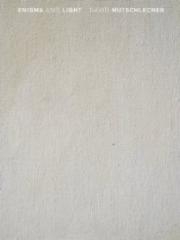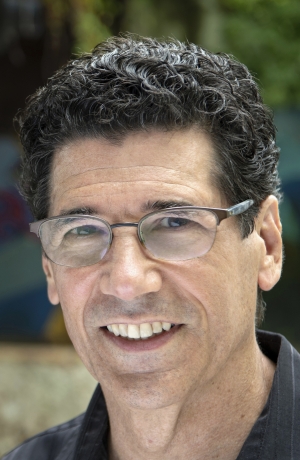
Enigma and Light
by David Mutschlecner
Ahsahta Press
David Mutschlecner has organized his fourth book of poetry, Enigma and Light, around Aristotle’s idea of metaphor as “the inherent similarity of dissimilars” (as Mutschlecner tells us in his artist’s statement). The book is jam-packed with references to a strange, provocative group of visual artists, philosophers, religious figures, and modernist writers. His titles reveal some of the odd pairings he explores: “Gertrude Stein / Agnes Martin,” “Robert Ryman / Nicholas of Cusa,” “Robert Duncan / Dante Alighieri,” and “Thomas Aquinas / Emily Dickinson.”
The titles imply that the poems will shed light on some similarities among these disparate figures. In “Gertrude Stein / Agnes Martin,” Mutschlecner finds unity in Stein’s poetry and Martin’s expressionist paintings:
Martin’s marks are Stein’s
word stipplings,
both inter-patterning one another
as they could not
without the clear delineation—
each word girded by the grid.
However, the poem goes beyond these two artists to include a number of other references to repetition and pattern—including Pound’s descriptions of image (a “radiant gist,” a “patterned event”) and the pattern of shadows created by the venetian blinds in Mutschlecner’s room. It ends with a prayerlike entreaty that points to his larger interest:
In every repetition
let meaning bless measure
and measure / meaning.
Repetition and pattern are what we rely upon to determine meaning. For Mutschlecner true understanding of the world must stem from an acknowledgment of the existence of an unknowable divine. These poems feature a captivating and complicated search for meaning that intertwines the physical world, the worlds of ideas and art, and the unknown.
Mutschlecner asserts throughout the book that entire worlds of meaning can be found in what appears to be emptiness. After describing minimalist painter Robert Ryman’s white-on-white paintings in the poem “Robert Ryman / Nicholas of Cusa,” he concludes thus:
Be careful
of the tabula rasa,
because there is already
a world there
just on the other side—
Another artist-philosopher pairing, “Oscar Muñoz / Emmanuel Levinas (After Two Pieces by Muñoz at Site Santa Fe)” describes Muñoz painting a portrait with water on concrete. As he paints, his brush lines disappear. Yet the image, in some form, remains.
The hand’s
alacrity
is exhausted by its efforts
while the face remains,
“its own
invocation.”
As the book progresses Mutschlecner increasingly introduces spiritual and religious references, and from these a unique vision emerges. He does not merely hint at some vague spiritual presence. As he states in “Georges Rouault / Robert Motherwell,” he wants to throw “Veronica’s veil / across the face of the deep.” (Veronica wiped the face of the suffering Christ, and, through a miracle, his image remained on the cloth.) Mutschlecner is seeking to find some evidence of God through his wildly shifting intellectual and intuitive probing of the unknown.
The poem “Saint Faustina / Karol Wojtyla” depicts Wojtyla (the future Pope John Paul II) walking through the streets of communist Krakow and finding an empty picture frame that once held an icon of Mary, the Mother of God. Although the image had been torn from its frame, everyone in the village knows it was there.
It was
by holy imagination
not really missing.
Who’s to say
the image was not in some way
more perfectly venerated,
presented so silently and then
submerged again in every heart.
For Mutschlecner, it is by “holy imagination” that a presence appears in the emptiness and can be “submerged again in every heart.”
Mutschecner’s Catholic faith is apparent, but these poems are never didactic. His interest is in discovery and connection. The pleasure in reading this book is following his meandering and often ecstatic search for a source of mystery and enlightenment.
The search culminates in the penultimate poem, “Enigma and Light in Every Relation I,” a meditation on prayer, praise, and the presence of God. It begins with Shadrach, Meshach, and Abednego from the book of Daniel, three young men who were saved from the fiery destruction of Babylon because of their devotion to God. Mutschlecner follows this with “Praise here the key. Praise / opens a chord in the beatific vision.”
He revisits Pound’s description of image as a “radiant gist.” Now it becomes a launching point from which God is revealed as a radiant, whirling presence in the world.
A radiant gist an image of God
in the midst of the furnace.
The midst of the furnace like a moist
whistling wind, a vortex through which
the Spirit passes, an
angelic ideogram
singing in the wind tunnel,
in holy Meta-
metaphor, across the margins of the scale.
What lies beyond metaphor is the spiritual—not a figure of speech but, for Mutschlecner, the affirmation of a mysterious, intensely present God.
The end of the poem returns to the “chord of praise” as an open-hearted embrace of faith.
Praise makes a place where breath tents the pray-er.
Praise the inherent similarity in dissimilars
inceptive to the Proem of the Cosmos.
Praise the Always More
A pentecost lies coiled in these relations
a spiral jetty
across the sweet salt water of the mind.
At a time when so much poetry is taken up with the unreliability of perception and language, David Mutschlecner’s unabashed embrace of mystery and faith stands out. Enigma and Light is a dizzying rush of ideas about art, philosophy, and religion that throws “Veronica’s veil across the face of the deep.” This work is to be greatly admired for its originality, intelligence, and joyful exploration of meaning and faith.


